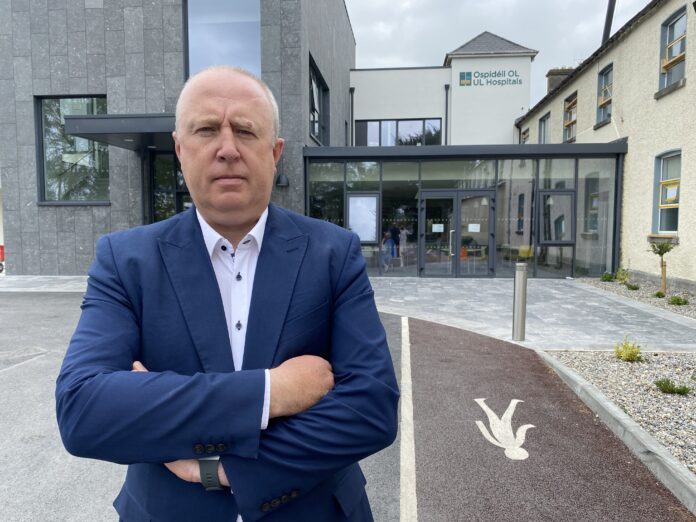
THE Chief Clinical Director of the UL Hospitals Group has conceded that University Hospital Limerick (UHL) cannot provide the type of patient care it wants to deliver due to unprecedented overcrowding at the hospital and inadequate bed capacity.
And he said that the “major internal incident” declared by the hospital group on Monday, as UHL became overwhelmed with patient numbers, would likely continue in the run up to the end of this week.
Prof Brian Lenehan, chief clinical director, said emergency protocols were triggered at UHL because “there were 170 patients in the emergency department” on Monday morning.
“That was unsustainable. The department and the waiting room were very overcrowded, and that is why we trigged the major internal incident protocol”.
There were 121 patients in the emergency department this (Tuesday) afternoon, but Prof Lenehan said this figure “isn’t unexpected” during winter time.
While the pressure on the Limerick emergency department had “started to improve” the present patient surge at the hospital “is going to take number of days to work through”, he said.
“A major incident is called when we do not have the resources available to us to deal with the volume of patients who have presented,” Prof Lenehan explained.
Additional emergency department consultants, nurses, consultant physicians and surgeons, clerical administrators and management, have been deployed to the frontline of the Limerick hospital “to try to decompress the emergency department”.
Additional surge beds have been accessed at Ennis and Nenagh hospitals and a surge ward has been created at Croom Orthopaedic Hospital.
“We have essentially maximised the surge capacity on the University Hospital Limerick site in Doodadoyle,” Prof Lenehan told Joe Nash, presenter of Limerick Today radio programme on Limerick Live 95.
He said he had no comment to make in response to County Limerick Independent TD Richard O’Donoghue’s recent call for senior management at UHL to resign.
“The senior management team at UHL work tirelessly to address the situation to try and expedite the care of our patients; to try and get approval for additional bed capacity, additional non-consultant hospital doctors, consultants and allied healthcare professionals,” Prof Lenehan said.
While he argued that patient overcrowding was “not unique to UHL” he agreed that “sustained high attendances are considerably worse at UHL than in other regions”.
Management at the hospital have called for at least another 200 beds to meet present demand.
“We have a particular bed capacity – when you do not have enough beds to put your patients into, you can’t deal with the volume of patients that are attending the emergency department”.
The Limerick emergency department replaced UHL’s previous Accident and Emergency unit in 2017, however Prof Lenehan said the emergency department was no longer meeting demand in the region.
In 2009, all 24-hour accident and emergency services in Ennis and Nenagh were reconfigured to UHL. However, many in the region have argued the decision has exacerbated hospital overcrowding in Limerick.
“When the new emergency department was opened in 2017, the planned capacity at that stage was for 190 patient attendances per day. We have seen up to 290 attendances a day, and we have seen sustained attendances at over 250 a day,” Prof Lenehan said.
“And that does not include the volume of patients that are seen in our local injury units and our medical assessment units in Ennis, Nenagh and St. John’s hospitals.”
He added that almost 80,000 patients attended the emergency department at UHL in 2022, which was “the highest number of any emergency department, anywhere in the country”.
Figures published by the Irish Nurses and Midwives Organisation showed that 97 patients were waiting on trolleys at UHL today.
Prof Lenehan said the hospital was in regular contact with an expert HSE Performance Management Improvement Unit (PMIU) which was deployed to UHL last year to try to plan ahead for expected overcrowding after Christmas.
“We are still in contact with them. We are continuing to implement the work streams that we developed in collaboration with them.”
“We have more of a focus and more staff whose focus is on patient flow. We have more non-consultant hospital doctors commencing in our emergency department next week and we’ve approval for additional emergency department consultants, so all of these take some time to bed-in, because you have to recruit.”
Heart attack, stroke, and other critically ill patients in the region were still being prioritised at UHL while non- emergency patients would continue to experience “exceedingly long delays”.
Prof Lenehan said these non-urgent patients would continue to likely wait eight to ten hours to be seen by a doctor.
He said claims that patients were waiting up to three days to been seen by a doctor in the emergency department were not correct. However he said it was taking days for admitted patients to be provided with a traditional bed on a ward”
Earlier today, the emergency department was full of patients who had either been seen by a doctor or are awaiting admission on a trolley, be that in a cubicle or on a corridor.
Prof Lenehan said the Health Service Executive (HSE) as well as the hospital management had discussed plans last December in anticipation of a surge in patient demand after Christmas, but he said that high levels of flu combined with Covid-19 and RSV cases had exacerbated pressure on the hospital.
“There was multiple models developed by the HSE, there were multiple meetings in early and late December nationally and locally to prepare for the surge, so we have prepared as best we can, we are utilising all of the surge capacity we have,” Prof Lenehan said.


